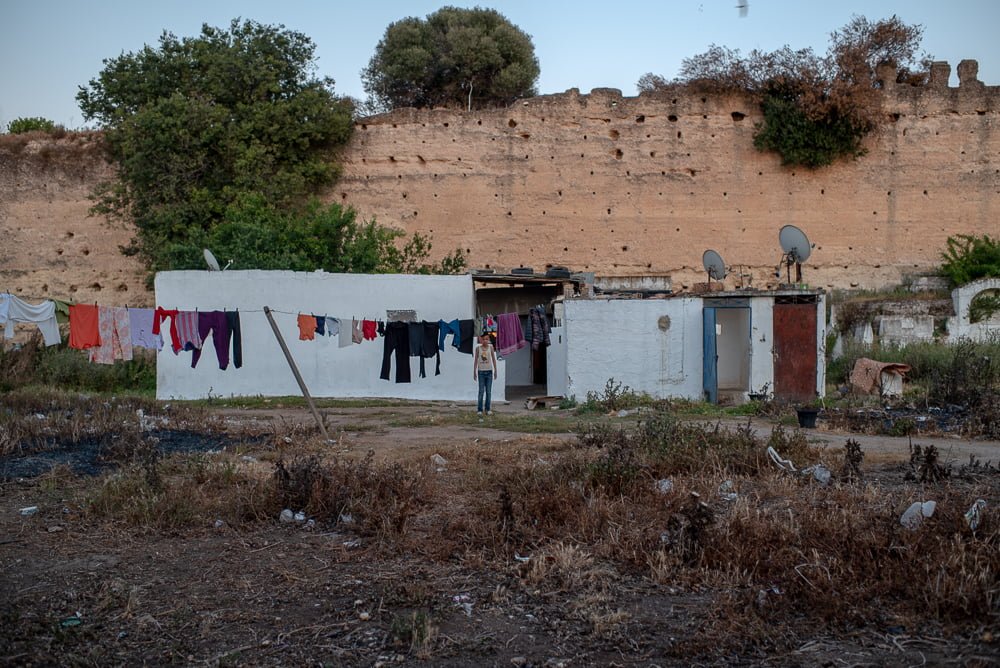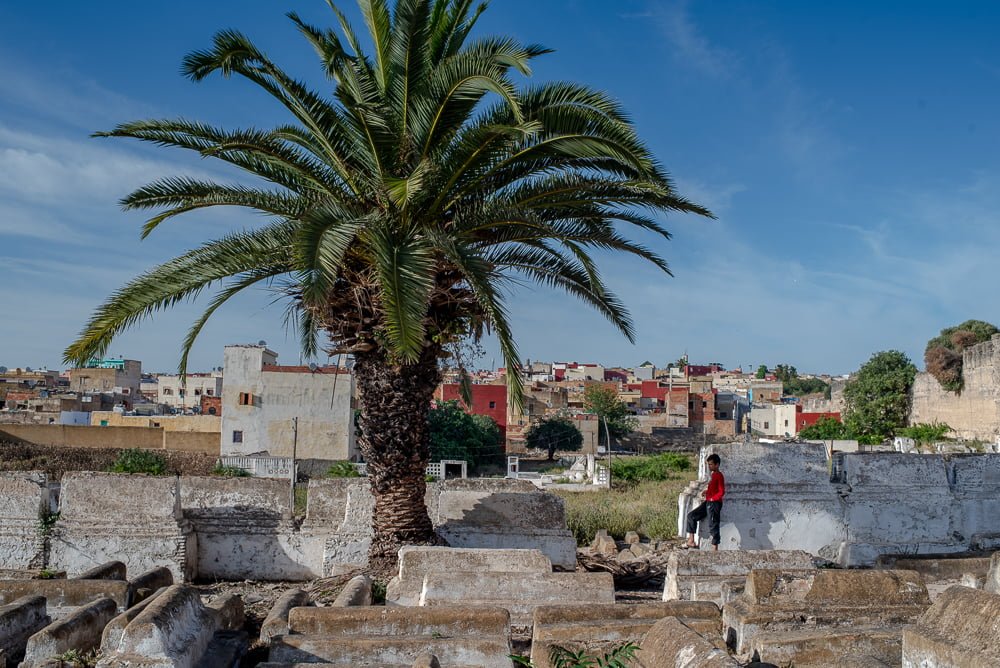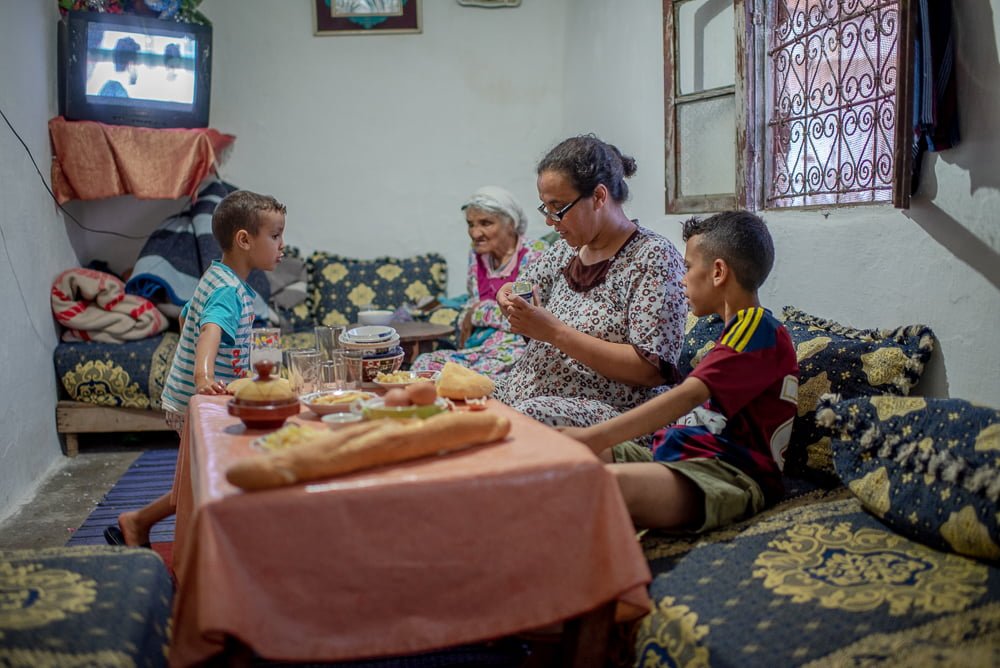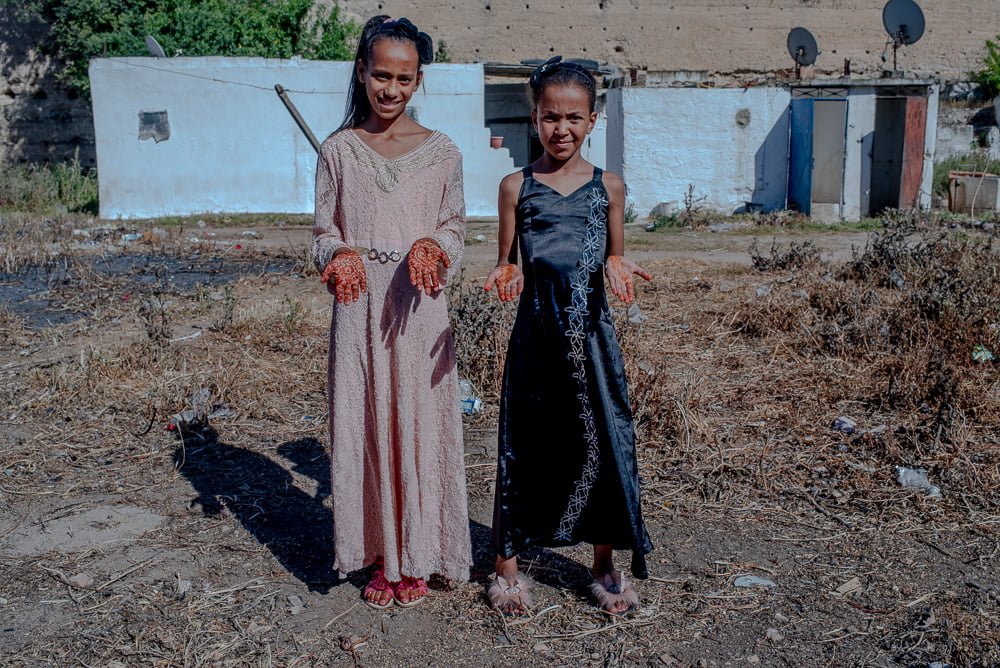Link to a full Gallery of images here.
The low concrete dwelling was as white as the line of old tombs to its right, sepulchres built into the tall medina wall which formed one boundary of the old cemetery. A young boy emerged from the dwelling and approached me, his body appearing to lope rather than walk, his eyes cast mostly downwards. Another child emerged from the white dwelling and made her way towards us. In contrast she walked straight up to me, looked me in the eye, and in a moment of young feminine purpose extended her arm palm open, smiled disarmingly and asked me without any shame whatsoever for ‘l’argent’.
The children were two young members of a large extended family living across several properties inside the walls of the Juif Cemetery Ancienne in Meknes. Gardiens for the sacred site, a family member will guide visitors of Moroccan-Jewish descent across the cemetery to the graves of relatives if known and then specifically to the tombs of several Rabbis buried there. The family member then waits patiently as the outsiders make their connection and once feeling satisfied will guide them to one of the 2 exits where a small donation towards family funds is expected. If the visitors provide their own guide the family are not needed but watch events intently from the window inside the dwelling as the strangers traverse their world, opportunity for some welcome dirhams denied.
Generations of Jewish settlers and merchants have lived in Morocco and across the Maghreb since biblical times, comfortably predating the establishment of ‘mellahs’ by a succession of sultans. Mellahs were designated and walled off areas of occupation exclusively for Jewish people created largely as a result of a massive migration of Jews forcibly resettled from the Iberian peninsula by the 1492 Alhambra Decree. This edict was introduced by Spanish Christian monarchs Isabella and Ferdinand and persecuted and expelled practising Jews. The first two mellahs were created in Fes and Marrakech, and Meknes was the third, founded in 1682 by Moulay Ismail. Meknes is the only city in Morocco which has two mellahs, the old and the new. The second mellah, adjacent to the first just across a busy road, was built in the 1920s. Each mellah had their own synagogues and their own cemetery.
The original cemetery in Meknes, which interested me the most, was entered from a corner of the old mellah by passing through an unmarked black metal door besides a row of blue and white houses; a doorway which connected the living to the dead.
I returned a number of times over the following days, pulled there by my own cultural lodestone. The photographs I had taken of the graves were technically satisfactory but uninspiring and lacked human dimension. The boy sometimes followed me around, keeping a little distance, quiet, but attentive, and sometimes pointed for me to go to another part of the cemetery which I assume he considered more photogenic. Occasionally I would invite him to look through the camera’s viewfinder and demonstrate how to focus and activate the shutter. I photographed him several times as a small feature within the wider landcape which he seemed to passively accept.
Each evening a group of young men arrived carrying food to prepare their Ramadan ‘breakfast’ of iftar, using tombs as tables. They called me across and asked me to take their photograph as they created their tagine. Sometimes they climbed the walls of dilapidated structures and pretended to be statues in the fading pre-dusk light. Once their meal was fully prepared they returned to the mellah where their dish was baked in the communal oven. At this time of the evening, the boundary walls and palm trees and the white tombs were transformed into salmon pink in the last light of the sun, the many holes in the walls attesting to former scaffolding marks now used by birds as nesting sites.
Throughout the day other people came and went from the white dwelling. Several older men pushed empty work trolleys backwards and forwards. Other children came and went sometimes on an old bicycle which they took turns playing on. The smallest child had a pedal car he drove and pushed along the mud path as far as the mellah door. The young girl and her friends would come and go. Intriguingly a frail old lady occasionally walked around the cemetery stopping and standing in the shade at particular sites. At other times several adult women would hang washing out to dry, or walk to and from the mellah with shopping bags. Other times they called to the children playing in front of the dwelling in the space where there was no graves. Most of the time a small flock of sheep grazed on the grass between the tombs.
Living in a cemetery in Meknes, former capital of Morocco, did not seem to be stigmatising nor restrictive. I had seen that Morocco had a close and respectful relationship with death where often descendants of people long deceased live in, or nearby, or regularly look after, family tombs. Far greater legal protections exist for graves in Morocco than in many countries.
One late afternoon the boy gestured for me to follow him to the dwelling. We passed by a small outbuilding and entered an enclosure where doors led off into different parts of the building. He led me into his family’s collection of rooms where I met his mother, his older sister and his younger brother. Finally I met the lady who walked around the cemetery like a wraith, his maternal grandmother. His mother, Hanan, asked if I wanted to share iftar with them that evening.
This began a trend which lasted throughout the remainder of my stay in Meknes. I did not eat with the family every evening but did so most nights. The meal, greatly anticipated, was delayed until sunset and the apocalyptic boom which sounded throughout the city, like an explosion, left no-one in any doubt as to the significance of the time. The meal focused around the serving of harira soup with a small pile of dates, the soup eaten by supping from the bowl and dunking with fresh bread. Hanan served the soup from a large aluminium saucepan into bowls on a table in the lounge; there seemed to be no dining room. These traditional foods were followed by boiled egg in its shell, potato pats, some morcella tinned meat ( cut and dispensed equally amongst all by Hanan ) , sweet pastries and bread. Sometimes family members would make a sandwich with most of the foodstuff, filling the bread. Two types of chilled delicious fruit juice would be offered, orange and strawberry, poured from pre-filled plastic bottles. The first evening there was also fish tagine. Sometimes there would be a small pudding, something like a non-sweet rice dish. The family ate together, chatting all the way through, the conversation urgent, guttural, affectionate and demonstrative in the Moroccan way.
Following the meal there would invariably be a walk, either to a small funfair beside the Sahrij Swani lake created by Moulay Ismael or around the busy souks in the medina. Returning from the fair we walked alongside the large walls of the Imperial Palace built centuries before and passed a large collection of noisy egrets roosting in the trees and shrubs beside the road, their tall white bodies ghost-like in the darkness. In the souks the mother and daughter always negotiated ruthlessly for a ‘good price’, buying new clothing which I was to later see worn in the coming celebration. The boy appeared to drift along during these shopping events oblivious to all. Irrespective of where we walked we always stopped for snail soup, sitting on small tables and chairs watching seemingly endless lines of people pass by as the collection of empty shells accumulated. On another evening we went to visit a family friend in the mellah where I saw first hand the difficult living conditions many families endured.
Throughout this time the temperature had increased; nearing 40 degrees some days, and it became too hot to to be active. When I joined the family in the late afternoon everybody sat immobile in the shade, keeping cool. The light was too bright and photography became difficult, the contrast range burning out the whites within a scene and making shadow regions too dark as can be seen in several photographs here. There was a tangible tension in the air as hunger and thirst grew throughout a long day, and the heat made the suffering more difficult. As the end of Ramadan approached, relief was in the air and Eid was greatly anticipated.
The last ten days of Ramadan are considered highly blessed, especially the 27th night which is called laylat al-qadr – the “Night of Power,” or the “Night of Destiny.” It is believed that on this night the prophet Muhammed received the first revelation of the Qur’an. For many Muslims, this 10-day period is marked by a heightened spiritual intensity, and they may spend these nights praying and reciting the Qur’an.
After 30 days of fasting, the end of the month of Ramadan is observed with a day of celebration called Eid-ul-Fitr. On this day, Muslims gather in one place to offer a prayer of thanks. It is traditional to wear new clothes, visit friends and relatives, exchange gifts, eat delicious dishes prepared for this occasion. It is time where the physical denials and spiritual achievements of Ramadan are acknowledged and celebrated. On this day Place el-Hedime, the large public square in Meknes, was alive with activity. Snake charmers, monkeys, acrobats, beautiful horses with elaborate saddles, food stalls, games and toys for children to hire for a short time or buy, great replica lions which children queued to sit astride. The most popular seemed to be a small illuminated spinning toy which could be sent skywards by pulling on a string and, like coloured purple and green glow flies, whizzed through the night sky. Hanan’s children wore their best new clothing we had acquired in the souks days before and everywhere women and girls making henna were huddled in small groups. In between these activities piles of clothing were sold, sellers standing on flimsy contraptions high above the crowds shouting out prices. There were few tourists here as in Jmaa el Fna in Marrakech; this was an authentic Moroccan celebration for Moroccan people.
One afternoon I went and saw that the boy had shot down a kestrel with his catapult. There is a long tradition of falconry in Morocco, called tabiyazt, which was introduced by the Arabs in the 12th century. It is a form of hunting live prey using trained raptors. I had no idea what the boy had in mind with the captured kestrel but he held it like a prize by the tips of its wings, giving the impression that at last he had something he could control.
My time in Meknes passed quickly by. I had experienced just over 1 week of Ramadan there, and although I didn’t fully comply with the observance of fasting I ate harira soup every evening at the iftar time, either with Hanan’s family or a small street cafe where it was served over a small counter for 6 dirhams, eating in a street mostly empty apart from the local single males with no families who were also eating too. I made several trips to Moulay Idriss, where the founder of Morocco is buried, and explored the colourful Marabout’s shrine on the outskirts of Meknes. My trips to Hanan’s family tailed off right at the end and I went to visit on my last afternoon to say goodbye, just before catching the coach to Essaouira. A relative I had not met before greeted me at the white dwelling and told me that Hanan and family were visiting family for a few days in the country. My departure from Meknes seemed a little incomplete.
The old Jewish cemetery in Meknes, and its family members, provided a unique experience of culture in Morocco during an intensive occasion within the Muslim calendar.
A full Gallery of images can be seen here.




